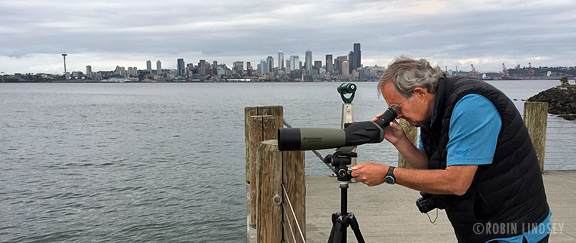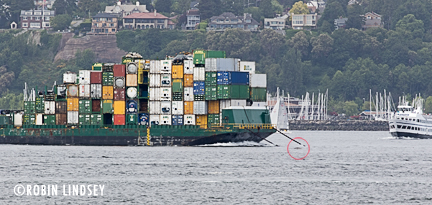Gray whale confirmed dead in Puget Sound
May/09/16 08:59 AM

Yesterday, Seal Sitters volunteers again contributed to the efforts to monitor the struggling gray whale, which had been floating in Central and South Puget Sound for 15 days. The whale was unable to dive.
Based on a report to OrcaNet and from other members of the marine mammal stranding network, SSMMSN first responders sighted the gray at the entrance to Elliott Bay and tracked the emaciated whale’s movements throughout the afternoon, as it drifted slowly in the currents between West Seattle and Magnolia’s Elliott Bay Marina. Our observations led to a firm belief that the whale had died, as we could see no blows during our lengthy observation.
A number of pleasure craft and tour boats violated the Federal Marine Mammal Protection Act (MMPA) by approaching the whale within mere yards. This, long before official confirmation of the animal’s death. The MMPA law requires a minimum distance of 100 yards from whales. Yesterday’s photos of those vessels in violation are being forwarded to NOAA’s Office of Law Enforcement.

Late in the afternoon, a US Coast Guard boat on the water confirmed that the whale was deceased. Because the flukes and pectoral fins are so low beneath the surface, they are not accessible at this time to secure a tow line and enable a necropsy.
Should you spy the whale, please continue to report sightings in a timely manner to OrcaNet’s email so that the stranding network is aware of the location.
If the animal is sighted along the West Seattle shoreline, please contact our hotline as well at 206-905-SEAL (7325).
This has truly been a team effort of the stranding network groups and the public of Puget Sound. Learn more about the work of NOAA’s West Coast Marine Mammal Stranding Network here.
UPDATE: MAY 12, 2016
A necropsy was performed by Cascadia Research with assistance from the Navy, WDFW, NOAA, and the Pt. Townsend Marine Science Center. Due to trauma or illness (as of yet undetermined), gases were trapped in the organs of the whale which prevented the almost 30 ft female juvenile from diving and foraging. The whale was emaciated. Tissue samples have been sent out for tests. For more info and photos, please click here.







